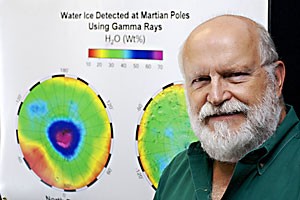The NASA Phoenix Mars Lander is gearing up for an August launch on a mission to explore water sources and seek organic carbon, building blocks of life, on the planet’s northern plains.
Led by the UA, the mission will try to determine, among other things, whether Mars might have been habitable in the past, said co-investigator William Boynton, a UA planetary sciences professor.
The lander, built by Lockheed Martin, will look beneath a frozen glacial landscape for evidence pointing to past life. The mission will also help establish what’s happening now on the planet as it pertains to the possibility for life.
The northern plains were chosen as the landing spot largely because scientists know the location holds water in the form of permafrost, or subterranean icy soil.
“”Phoenix has been intended to observe the history of the ice by measuring how water has modified the chemistry and mineralogy of the planet’s soil,”” said Peter Smith, the mission’s principal investigator at the UA.
The lander will explore the conditions of the ice to find out if it ever thaws and provides a condition for microbes to be present. It will use sophisticated tools to dig into the soil.
Phoenix will also observe polar weather and the interaction of the atmosphere with the surface, Smith said.
The long-armed robotic lander is planned to launch during a three-week period beginning Aug. 3. The 122-million-mile trip should convene next spring.
At that point, the lander’s nearly 8-foot-long robotic mechanical arm will excavate ditches up to 3 feet deep. A camera and conductivity probe on the end of the arm will study soil and any ice.
Next, the arm will raise the samples on to the lander’s deck, where they will then be transferred to a Thermal and Evolved Gas Analyzer. The TEGA will use heating to check for volatile substances like water and carbon-based chemicals that facilitate life.
Finally, the TEGA will measure the temperature of and evolved gas profiles in the ice that uniquely identify volatile-bearing minerals.
“”The lander will stay there on the surface and it will live for about six months, but we are so close to the north pole on Mars that eventually the spacecraft will not survive the winter,”” Boynton said.
Devin Harshman, a management information systems senior, is working on the project as a student employee. He said that while he’s mostly done a lot of odd jobs for the TEGA, the experience as a whole has been helpful.
“”Working with the department and the advanced technology has really helped me and given me a better understanding of computers and my major,”” Harshman said.
This mission is different from past missions, including those executed with Mars rovers Spirit and Opportunity, which were used to conclude only what happened on Mars in its past.
“”This mission is the first to go to the far northern region of Mars,”” said Sara Hammond, public affairs manager of the Phoenix Mars Mission. “”We expect to be the first to actually touch water.””
The original main structure for the spacecraft was built for the Mars Surveyor project in 2001, said Gary Napier, public relations official for Lockheed Martin Space Systems Company.
“”We redesigned the unused spacecraft and reused it for the Phoenix launch,”” he said.
The cost of the mission, funded by NASA, is $420 million, which includes the spacecraft, science operations and the launch vehicle, Napier said.
“”This has great impact for not only the UA, but (also) the state of Arizona,”” Hammond said. “”The whole world will be watching, and this will further put the university on the map.””









